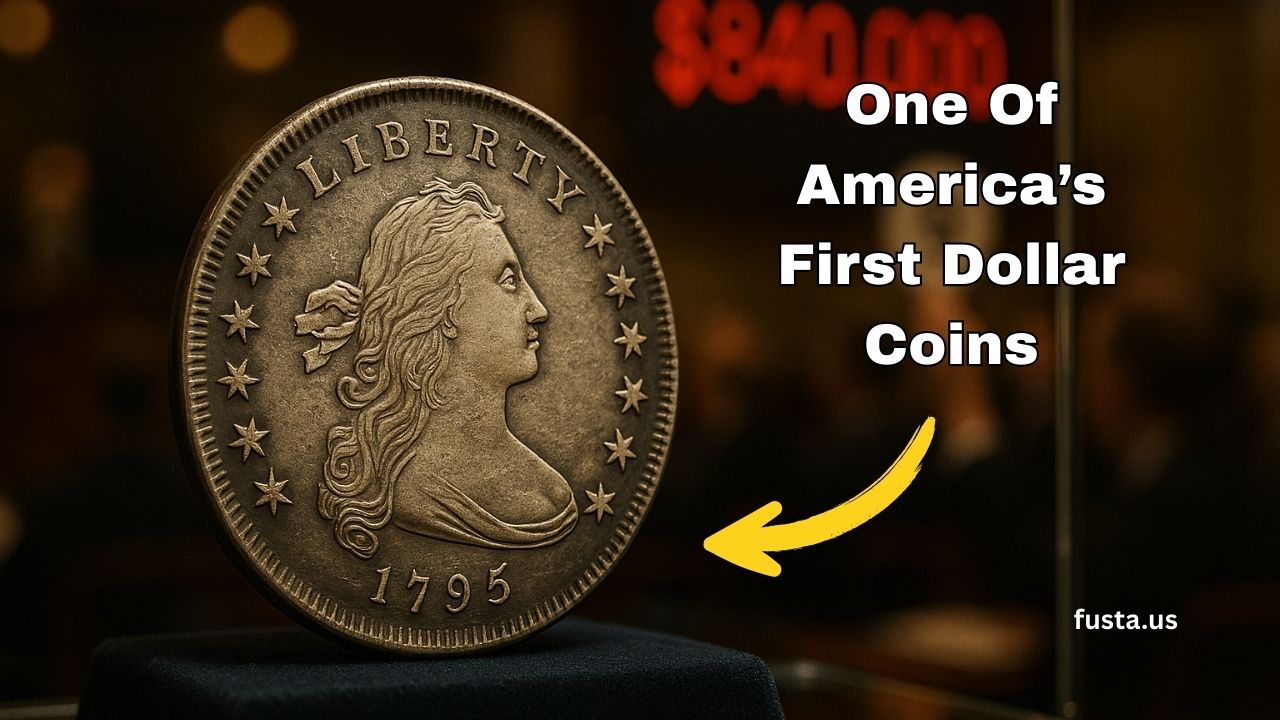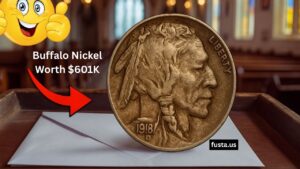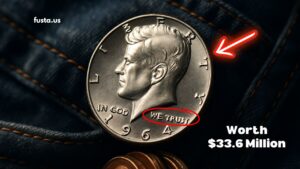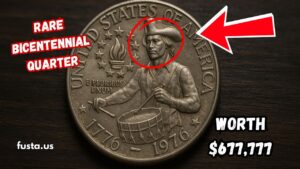A one-of-a-kind early American dollar has stunned the numismatic world with a $840,000 hammer price.
This historic piece isn’t just any coin—it’s a 1794 copper prototype (often called a pattern) for the first U.S. silver dollars.
Struck in the fledgling Philadelphia Mint at the dawn of federal coinage, the coin features the Flowing Hair portrait of Liberty and a small eagle reverse.
Beyond its beauty, the coin’s value lies in its unique status, its direct link to the first federal dollars, and its place in the story of the American monetary system.
Below, you’ll find the full context behind the sale, what makes this coin extraordinary, and how it connects to the broader market for early U.S. dollars.
What Exactly Was Sold?
The record making piece is a 1794 copper “No-Stars” Flowing Hair dollar—a prototype used by the Mint while refining the dies for the first silver dollar issue.
Unlike the later circulating silver dollars, this trial piece shows no border stars around Liberty’s portrait, a design detail that helps specialists identify it from the standard production coinage.
Key features collectors care about
- Type: 1794 Flowing Hair dollar (copper prototype / pattern, not a circulating silver piece)
- Obverse: Liberty with flowing hair; no stars around the rim
- Reverse: Small eagle perched within a wreath
- Metal: Copper (prototype for the silver dollar dies)
- Mint: Philadelphia (1794)
- Status: Unique or effectively unique in private hands, with museum comparisons known
Because this was a trial strike, it captures the transitional moment when the Mint was finalizing the first federal dollar design—a huge reason it electrified bidders.
The Auction- Price, Venue, and Bidding Drama
- Auction venue: A leading U.S. auction house known for headline numismatic results
- Sale date: Late April 2021
- Pre-auction estimate: $350,000–$500,000
- Opening bid: $312,000
- Final price realized: $840,000
The coin blew past its estimate, with bidding escalating rapidly once it crossed $500,000.
High-end collectors recognized that opportunities to own a prototype of America’s first dollar are nearly nonexistent. The price reflects pure historic scarcity more than anything else.
Why the $840,000 Figure Makes Sense
The headline number might seem surprising until you look at the market context for early American dollars:
- First-year silver dollars of 1794 in elite grades have realized multi-million-dollar prices.
- Patterns and prototypes—especially pre-production pieces tied to a “first”—often command outsized premiums because they are singular and conclusive artifacts of design and engineering.
- The story matters: this coin bridges the gap between concept and production, giving collectors a front-row seat to the birth of the U.S. dollar.
Design Details That Drove Demand
Collectors and historians prize several attributes on this piece:
- No-Stars Obverse: The absence of stars distinguishes it from circulating issues and signals an experimental phase in the Mint’s design process.
- Flowing Hair Liberty: The earliest federal portrait of Liberty—an icon of the nation’s first coinage program.
- Small Eagle Reverse: The earliest American eagle motif, enclosed by a laurel-style wreath, tying it directly to 1794–1795 artistry.
Provenance & Notable Ownership
The coin has been associated with high-profile collectors and elite cabinets, further boosting its desirability. In numismatics, provenance acts like a pedigree.
When a coin has museum-quality peers and a traceable ownership chain, confidence—and prices—tend to rise.
How It Compares to Other Early Dollars
Even though this is a copper prototype, it sits beside the famous 1794 silver Flowing Hair dollars at the top of the market in historical significance.
- Production 1794 dollars: Among the most coveted early U.S. coins, with top specimens selling for many millions.
- 1795 silver dollars: Still classic early federal dollars, but typically less than the towering 1794 price records.
- Prototypes / Patterns like this 1794 copper piece: Rarer than rare, often unique, and therefore un-priceable until a major sale establishes a benchmark—as happened here at $840,000.
Market Takeaways for Collectors
This sale underscores several lessons:
- Rarity + Firsts = Power: Coins tied to “first of its kind” moments carry enduring premiums.
- Condition isn’t everything: Eye appeal and preservation matter, but historical singularity can eclipse grade in driving price.
- Story sells: Clear links to key milestones in U.S. coinage history create deep demand from both collectors and institutions.
Fast Facts on the $840,000 1794 Prototype Dollar
| Item | Details |
|---|---|
| Coin | 1794 Flowing Hair Dollar (Copper “No-Stars” Prototype/Pattern) |
| Metal | Copper (trial for the first silver dollar dies) |
| Obverse | Liberty with flowing hair, no stars |
| Reverse | Small eagle within a wreath |
| Mint/Year | Philadelphia, 1794 |
| Rarity | Unique / effectively unique in private hands |
| Pre-Sale Estimate | $350,000–$500,000 |
| Opening Bid | $312,000 |
| Final Price | $840,000 |
| Significance | Prototype for America’s first silver dollar; pivotal early U.S. Mint artifact |
Why This Matters Beyond Coin Collecting
For historians, economists, and anyone fascinated by America’s founding era, this prototype is a time capsule from the moment the nation began issuing its own money. It reflects early debates about design, symbolism, and identity—and the practical challenges of launching a mint, preparing dies, and aligning art with metallurgy. Each detail—Liberty’s hair, the youthful eagle, the absence of stars—captures the experimental spirit of 1794.
Tips for Spotting Important Early U.S. Dollars
If this sale inspires your own search, keep these collector tips in mind:
- Know the Types: Flowing Hair dollars (1794–1795) are the inaugural series; they’re the bedrock of early U.S. silver.
- Look for Provenance: Famous collections, museum comparisons, or auction-house archives help verify authenticity and importance.
- Beware of Alterations and Fakes: High-value early dollars invite counterfeits. Serious collectors rely on recognized grading services and well-documented provenance.
- Patterns vs. Circulation: Patterns (prototypes) are test pieces; they can be copper even if the final coin was silver or gold. Their rarity can exceed that of regular issues.
The $840,000 sale of the 1794 copper “No-Stars” Flowing Hair dollar underscores the timeless allure of “firsts” in American coinage.
As a prototype for the earliest U.S. silver dollars, this piece compresses art, history, and nation-building into a single artifact.
Its result—well above pre-sale expectations—confirms that uniqueness, provenance, and a compelling origin story can propel early American coins into the upper strata of the collectibles market.
For enthusiasts and investors alike, this sale is a powerful reminder that numismatic history still has the ability to surprise—and to set remarkable new benchmarks.
FAQs
What makes this 1794 piece a “prototype” rather than a regular dollar?
Because it’s a test strike in copper used to refine dies for the first silver dollars. It features design differences—like no obverse stars—that mark it as experimental, not a production.
Why would a copper coin be worth more than many silver dollars?
Rarity and significance. A unique or nearly unique prototype tied to the first U.S. dollar can out-value common silver issues because it represents an irreproducible moment in minting history.
How does this compare to prices for actual 1794 silver dollars?
Top 1794 silver dollars in exceptional condition have sold for multi-million-dollar figures. While this prototype isn’t silver, its singularity and direct design link to the first federal dollar placed it at a market-moving $840,000.




